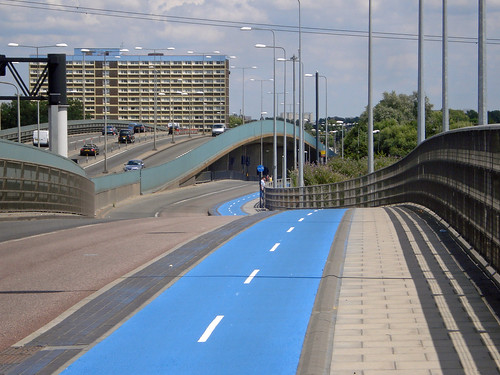全歐最長 倫敦將建分隔式單車專用道
摘譯自2015年2月6日ENS英國,倫敦報導;姜唯編譯;蔡麗伶審校
倫敦市長Boris Johnson近日履行了他的承諾,市民將擁有歐洲最長的分隔式自行車專用道。
超級高速公路 縮短尖峰時刻
倫敦交通局4日核准了市長1億6千萬英鎊(新台幣77億4千萬)的分隔式自行車專用道預算,並將於3月動工。這條藍色的自行車道將縱橫交錯於倫敦市區,並如自行車騎士所要求,有水泥鋪面且與一般車道分隔。
最大筆支出在於兩條爭議性的「自行車超級高速公路」,穿越倫敦中心、連接東西和南北。倫敦市長稱之「開啟數千條新旅途的可能性」。
市長的自行車道計畫將改變倫敦部分最繁忙的道路和十字路口,某些情況下可能會讓自行車和動力車輪流通行。
為解除自行車和動力車輪流通行恐導致東西向道路交通延遲的疑慮,市長改變計畫,保留上下泰晤士街和維多利亞堤岸的兩條西向車道,同時維持連續分隔式自行車道和路口。市長辦公室表示,此改變比起原計畫可減少早晨尖峰時間延誤達60%,從16分鐘減少到6分鐘。
自行車道也友善行人 8成市民支持
兩條自行車道都將對行人更加友善,多了數千公尺的步道、22條新穿越道、縮短35條穿越道以及增加41條有行人倒數時間的穿越道。
倫敦交通局花9周時間針對自行車道進行諮詢,蒐集21,500人的意見,有84%支持自行車道計畫。
自行車道周邊,包括聯合利華、蘇格蘭皇家銀行、橙縣德勤公司等超過100個主要商業行號以及倫敦議會也公開支持自行車道計畫。
倫敦交通局將和車道沿線公司合作,最佳化管理出入運輸,協助他們避開尖峰時間,減少全倫敦不必要的壅塞。
10年間倫敦的自行車使用量成長1倍。今日中倫敦的尖峰時間有1/4的交通來自自行車。
同一時期,東西超級高速公路維多利亞堤岸的動力車交通減少了24%,南北超級高速公路法靈頓街減少44%,兩條路上有60%至70%的交通是私有車輛和計程車。
整體而言,倫敦計畫投注超過60億美元於其「道路現代化計畫」,該計畫包括先進的交通號誌技術,能根據任何時刻的狀況調控交通流量。
Transport for London Approves New Cyclist Superhighways
The construction of Europe’s longest segregated urban cycleways is set to begin in March, now that the Board of Transport for London (TfL) has approved London Mayor Boris Johnson’s commitment to get more Londoners on their bikes.
The TfL Wednesday approved the mayor’s plan to spend £160 million (US$245 million) on curb-segregated bike lanes. Criss-crossing the city, blue-painted bike lanes will be divided from the main roads by concrete curbs, a separation urged by cyclists.
The biggest investment will be on two controversial “cycle superhighways” running east-west and north-south through central London, opening up what Mayor Johnson says will be thousands of new journey opportunities.
The mayor’s cycleway plan will change some of London’s busiest roads and intersections, in some cases prohibiting all traffic except cyclists from making turns that now are legal.
Acting on concerns about delays to motorized traffic caused by such restrictions on the east-west route across the city, the mayor changed his plan to retain two westbound traffic lanes on Upper and Lower Thames Street and Victoria Embankment, while preserving the continuous segregated cycle lanes and junctions.
The changes reduce the whole-route traffic delay in the morning rush hour, the worst affected time, by 60 percent compared to previous proposals.
The delay is now reduced from 16 minutes to just over six minutes in the busiest morning hour, the Mayor’s Office said in a statement.
On both routes, there would be substantial benefits for pedestrians, with thousands of meters of extra footway, 22 new crossings, 35 shortened crossings and 41 crossings fitted with pedestrian countdown.
TfL’s nine-week consultation on the cycleway proposals drew comments from 21,500 people, 84 percent of them favorable.
More than a 100 major businesses on or near the routes, including Unilever, Royal Bank of Scotland, Deloitte and Orange, also publicly backed the scheme, as did all parties on the London Assembly.
TfL also will work with businesses along the route to help manage deliveries in the best possible way, providing advise to enable them to move away from deliveries during the busiest times and help reduce unnecessary congestion across London.
Bicycle use in London has doubled in 10 years until today nearly a quarter of rush-hour traffic on central London’s roads is now bicycles.
Over the same period, motor traffic has fallen by 24 percent on the Victoria Embankment, or the East-West superhighway, and by 44 percent on Farringdon Street, the North-South superhighway. Between 60 and 70 percent of all traffic on these roads is private cars and taxis.
Overall, London plans to invest more than US$6 billion in its Road Modernization Plan, which includes sophisticated traffic signal technology that regulates traffic flow based on conditions at any given time.


沒有留言:
張貼留言